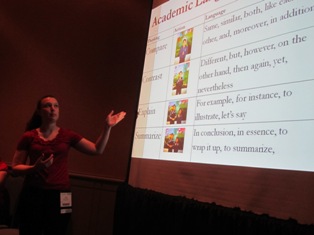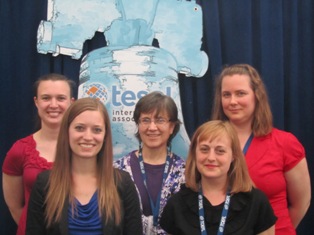|
MinneTESOL had the honor of sending a panel of members to the
TESOL convention in Philadelphia to present one of six “Best of
Affiliate” presentations. The panel, consisting of Susan Ranney, Kelly
Grucelski, Kelli Meyer, Molly Sanders, and Rainbow Espinosa, presented
“Minnesota Stories About Teaching Academic Language.” The stories grew
out of their experiences in enhancing their instruction of academic
language as the four ESL teachers in various K-12 settings participated
in an online class about academic language instruction taught by Susan
Ranney at the University of Minnesota.
The panel presented stories from their classrooms at the
MinneTESOL annual conference and were voted Best of the Conference by
conference attendees. MinneTESOL then sponsored the proposal they
submitted to the Best of Affiliate competition. For the four K-12 ESL
teachers, it was their first experience of going to the international
TESOL convention, and it was exciting to not only be able to attend the
large convention but also to be on the program as presenters.
Using video and pictures, panel members shared specific lessons
and approaches from their classrooms. In a charter school serving
mostly Somali immigrants, Molly Sanders taught elementary students the
language of cause and effect in the context of science content with
activities such as having students match causes and effects using
sentence strips, identify signal words, mark parts of sentences with
colored markers, and then produce their own language using sentence
frames.
Kelli Meyer told about teaching academic language to high
school English learners while they prepared for a special event at a
college called the World Affairs Challenge. As her students researched
food issues for their presentations at this event, Kelli developed
lessons that led them to analyze the use of demonstrative adjectives and
nominalizations in academic texts, and to use these forms productively
as they prepared their speeches.
As an example of academic language instruction in a different
institutional setting, Rainbow Espinosa presented her work with students
in a juvenile detention center, and demonstrated how she led adolescent
English learners to analyze the perspectives of a history textbook
using a functional linguistics approach.
In an elementary charter school serving mostly Spanish
speakers, Kelly Grucelski developed posters to teach the use of hand
gestures to enhance student learning of academic signal words. She also
detailed her use of journal writing to develop students’ academic
language skills for math classes.

Kelly Grucelski shares her visuals for teaching
English
language learners to use academic signal words
We also described the work of panel members who were not able
to make the trip to Philadelphia: Melissa Persson, who used Socratic
circles to develop oral academic language with her students in a
newcomer high school, and Iman Mefleh, who inspired middle school
English learners to use academic language in debates and in a letter
exchange with President and Mrs. Obama about the Let’s Move campaign. A
common theme of all the stories was the sense of empowerment that
English learners felt as they began to analyze, understand, and
productively use academic language while learning academic
content.
The audience at TESOL was engaged and asked many questions to
understand more about how the panelists had overcome common barriers to
academic language instruction. For the panel participants, the
experience was a wonderful professional development opportunity. Outside
of the time spent presenting, participants took full advantage of the
wealth of other sessions offered at the conference and then shared what
they had learned at the various sessions with each other in a gathering
after returning to Minnesota.
One of the best outcomes of being chosen as a Best of Affiliate
session was that it gave the opportunity of attending a TESOL
convention to four classroom teachers who would otherwise not have been
able to request the time off and travel expenses. Rainbow Espinosa
applied for and was selected to receive a prestigious TESOL travel
award. The other three teachers were funded by their schools.
The experience allowed the panelists to share our stories with
ESL teachers across the United States and to bring many enriching ideas
back to our classrooms in Minnesota. As Rainbow Espinosa said, “I think
the most important thing I got was being inspired to keep learning,
growing and doing my best. Teaching gets monotonous if you don’t refresh
yourself with new inspiration from teachers all over the world doing
amazing things! I saw the possibilities expanding of what and how to
teach English. What an awesome experience!”

“Minnesota Stories” panel: (left to right) Kelly Grucelski,
Kelli Meyer, Susan Ranney, Molly Sanders, and Rainbow Espinosa
Susan Ranney is the first vice president of
MinneTESOL. She is a senior lecturer at the University of Minnesota,
where she teaches courses for candidates for ESL licensure. She also
teaches a course on academic language for inservice K-12
teachers. | 
